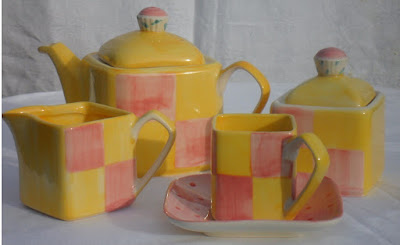I
am a bit of a purist when it comes to collecting china tableware, I do like
English China, especially produced in the Midland Potteries from the 1950s and 60s.
Lately
though I have been looking at some Marks and Spencer ranges. One in particular
has really taken my fancy. The Battenberg pattern, sometimes called Tea Time.
These
wares were not made in the UK, when I looked on the back the mark is, 'made in Taiwan.' I believe they are from
the 1980s - 1990s. Certainly not one of my usual infatuations, but I think
these are going to become very collectible. Using the example of Ridgway Homemaker sold in Woolworths in the 1950s's 1960's, this crockery could be picked up quite cheaply at the time, but is now commanding good prices.
 |
| Marks and Spencer Battenberg |
As
the name suggests the design on the teapot, sugar bowl, milk jug, cups saucers
and tea plates are inspired by the colours and shape of a Battenberg cake,
yellows and pinks. The shapes are square, very unusual.
Tea Time
Tea Time
Alongside
this range is a complementing set, of round cups saucers and plates, all
decorated in greens, pinks and lilacs, the
outside of these wares are decorations of cakes. They are lovely.
 |
| Marks and Spencer Tea Time |
One
of my favourites from this range is the large cake plate, the yellow cake stand
is edged with cup cakes and Battenberg cakes all standing proud.
The
whole range is an absolute delight. They would make a fabulous addition to a
little girls tea party, and would lend themselves so well to an Alice in Wonderland, or fairyland theme.




